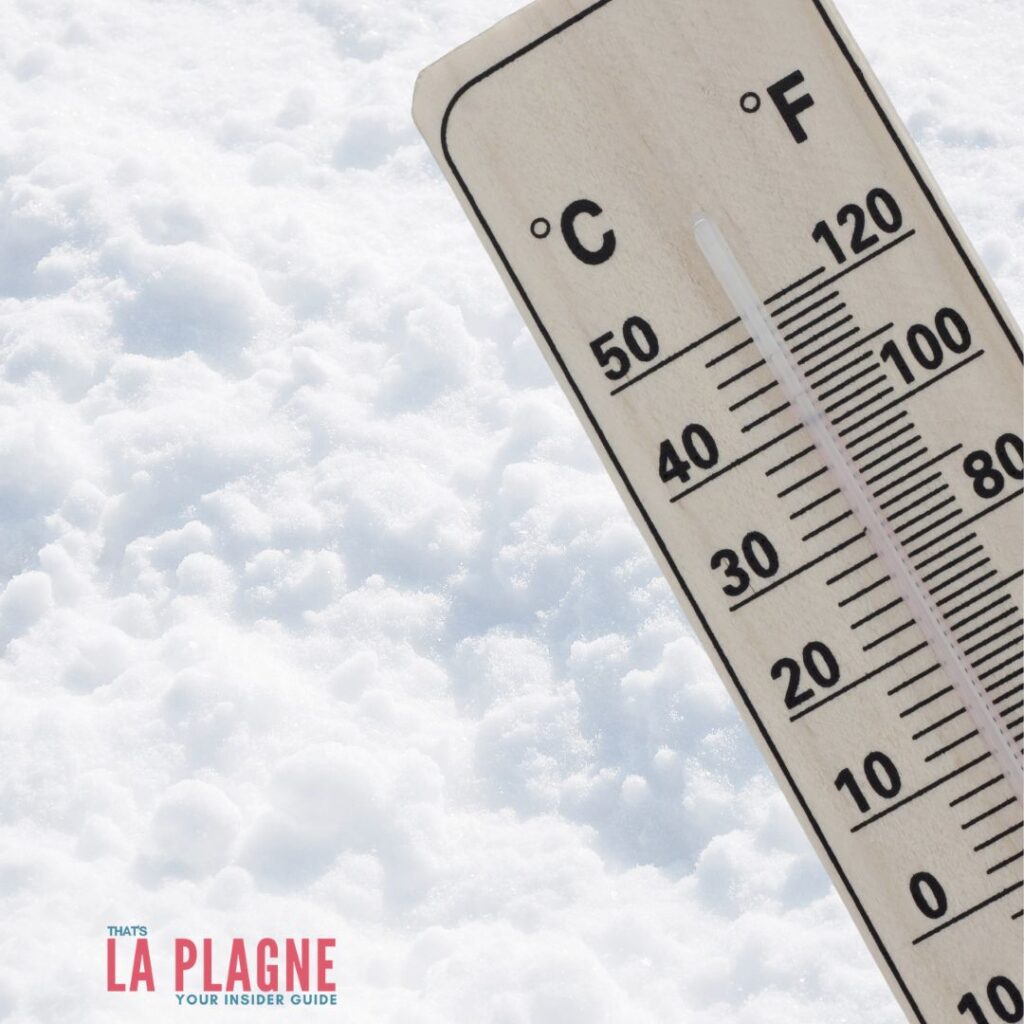That's La Plagne
Ski Clothing: What to Wear in All Temperatures

If you’re heading off on a ski trip this winter with your family, then you’re in for a treat! But in ski resorts, the weather conditions can vary dramatically, often with differences of +/- 20C within a couple of days! So, what ski clothing to pack and how to dress to stay warm and comfortable whilst skiing are two of the main questions you might be asking yourself.
Today, I’m going to break down some top tips for managing the differing ski resort weather conditions and then provide some examples of what I wear by temperature when I’m out skiing with my kids.
So, prepare to be warm and cosy and let’s get to it.
Join the inside track to get the story first from La Plagne.
Top Ski Tips for All Weather Conditions
Before we talk specific ski clothing in different temperatures, let’s cover the basics with some basic advice; whether you’re a seasoned pro or a family hitting the slopes for the first time, these top ski tips for all weather conditions will ensure you’re prepared for anything Mother Nature throws at you.
Plus, grab the best family ski holiday packing guide, where I’ve done all the tricky planning for you!
1. Layer Up Wisely
Embrace the art of layering. Instead of one bulky outfit, opt for multiple layers that you can adjust based on the temperature. This way, you can easily adapt to changing weather conditions throughout the day.
2. Stay Hydrated
Cold temperatures can deceive you into thinking you're not sweating as much, but staying hydrated is crucial. Drink plenty of water to keep your energy levels up and combat the effects of high-altitude skiing.
3. Protect Your Skin
Suncream is not just for sunny days. The reflection of the sun on snow can intensify its impact, leading to sunburn even on overcast days. Apply sunscreen to exposed skin, especially on your face, to avoid unpleasant surprises.
Check out my recent guide for some of the best sun creams for harsh winter climates and ski resorts.
4. Mind the Wind Chill
Understanding wind chill is essential for a comfortable skiing experience. Wind chill is the perceived decrease in temperature caused by the wind. Even if the thermometer reads a certain temperature, the wind can make it feel much colder – especially on chairlifts! Be aware of the wind speed and adjust your layers accordingly.
Most snow forecasts and reports will include the expected wind chill alongside the temperature, so make sure you check this as well.
5. Visibility Matters
Poor visibility can be a challenge, but with the right gear, you can navigate through it seamlessly. Invest in high-visibility clothing and accessories to stay visible to others on the slopes. This not only enhances safety but also allows you to keep an eye on your family members. You’ll also need different goggle lenses to increase your visibility in white-out conditions. Look for yellow-tinted and low-light goggle lenses. They really do make a big difference to how much you can see.
Read this guide to understand more about how you and your family can ski in poor visibility conditions.
6. Check the Weather Forecast
Stay ahead of the game by checking the weather forecast before hitting the slopes. This will help you plan your layers, choose the right gear, and anticipate any changes in weather throughout the day. I always recommend taking a backpack with you with some extra items in it, especially if you have kids.
For snow forecasts, I love Snow-forecast.com, and then for accurate piste reports and snow conditions in your ski resort, find local reporters. For example, I create weekly La Plagne ski and snow reports from the ski slopes and with a quick Google search, you’ll find the same for your ski resort.
7. Know Your Limits
While pushing your skiing skills can be exhilarating, it's essential to know your limits, especially in challenging weather conditions. If visibility is low or the wind chill is too severe, consider taking a break and enjoying the cosy atmosphere of a mountainside restaurant.
What ski clothing to wear for every winter temperature
There are some ski clothing items that you and your kids will always need to wear, regardless of the temperature on your ski holiday. When it’s warmer, it can be tempting to forgo the basic laters, but they are also for your safety. For example, if it is warm and you decide to ski without gloves, you could still fall and graze or damage your hands without the protection of gloves. It’s the same as wearing full protection on a motorbike, even in hot summers.
Remember always to include:
Gloves
- Mittons are a great option for kids, easier to put on and warmer than gloves. When I’m snowboarding, I prefer mittens, because I’m not holing onto poles. However, when skiing, I opt for gloves, so I have more grip and movement to hold onto poles – and kids!
- I always get gloves with elasticated straps for myself and for the kids so they can’t loose them on the slopes or ski lifts.
Hat
- A fleece or woollen beanie hat is a great extra layer. Opt for one without a bobble on it so it can fit snugly under a ski helmet.
- If you are wearing it under a helmet, make sure you check the safety guidelines of the helmet manufacturer to make sure this doesn’t compromise the helmet guidelines.
A neck buff
- The thinner buffs, common in Europe, are great as they have lots of extra material, which you can pull up over your ears to meet your hat and helmet and also tuck into the neck of your jacket. Careful layering means no skin is exposed to the cold temperatures.
- I have a large fleece one that I love from Eivy, it also has a hood on it, large enough to pull over my helmet on really cold days.
Socks
- Proper ski or snowboard socks are a must. It can be tempting to opt for cheaper tube socks or other sports socks. But ski socks provide you with necessary foot support, as well as keeping your toes warm. Moisture-wicking, warm socks with the option for a thin liner sock: Keep your feet dry and comfortable throughout your ski adventure.
Ski outfits for every winter temperature
Ok, now we’ve covered the basics, let’s jump into how these items of ski clothing might differ in the changing ski conditions and harsh winter climates.
Mild Conditions (10°C/50°F)
Outer Layer
- Light waterproof or water-resistant jacket. We would call this a shell jacket, as there isn’t much padding to it for warmth, just the waterproof and windproof layer to shield yourself from unexpected flurries while enjoying the milder temperatures.
Mid Layer
- Fleece or insulated jacket: A cosy layer to keep you warm without overheating. A basic sweater will be plenty, something with enough movement in it to ski comfortably. I prefer something that zips or buttons open, so if I am too warm, I can open it up.
Base Layer
- Long-sleeve moisture-wicking base layer: Stay dry and comfortable as you carve through the softer snow. Depending on how warm you are naturally, you might give this a miss and just opt for a vest or short-sleeve layer. I am always cold! So, regardless of the temperature, I’ll always have a base layer under my salopettes and a sleeve top. My husband, however, will often not bother with this layer.
Kids
- Similar layers with extra insulation: Kids need that extra warmth, so make sure their layers include insulation to keep them snug and happy. And the key is more but thinner layers that you can strip off if they are too warm.
Cool Temperatures (0°C/32°F)
Outer Layer
- Waterproof and insulated jacket: Lock in the warmth and keep the chilly breeze at bay. At this temperature, your shell jacket needs to provide some additional warmth. Sometimes, you can get jackets that have insulated layers you can add to your shell jacket.
Mid Layer
- Insulated or down jacket: Have a look at a lightweight down jacket that, whilst usually aren’t waterproof, fits perfectly under a lightweight jacket to provide extra insulation.
Base Layer
- Thermal base layer: Lock in the warmth close to your skin to combat the lower temperatures. Look for materials that will keep you warm but also wick moisture away from your skim. The queen of these base layer materials is Merino wool.
Kids
- Insulated jacket, additional insulation layer if needed: Little ones can enjoy the snow comfortably with layers that ensure they stay toasty during every snowball fight.
Chilly Weather (-10°C/14°F) & top ski clothing
Outer Layer
- Insulated and waterproof jacket: Upgrade your outer layer to tackle the dropping temperatures. It’s likely you might be in more icy conditions, either on the slopes or on chairlifts, so a jacket with a good waterproof rating is a must.
Mid Layer
- Insulated jacket or vest: Add an extra layer of insulation for those brisk mountain winds. I will often opt for an extra lightweight shirt or zipped jacket over the top of a sweatshirt to keep me toasty.
Base Layers
- Thermal base layer with moisture-wicking properties: Moisture management is key to staying warm and dry. If it’s really chilly, I’ll add a vest under my thermal base layer and then also a t-shirt over the top of my long-sleeved thermal top. As you can see, I’m a big fan of layering!
- From this temperature, I would also start to include a pair of glove liners to wear under my waterproof ski gloves or mittens.
Kids
- Ensure your kids are bundled up in warmth and protection against the chill. Again, I always opt for more layers than less. Kids are often more stationary than adults on skis, and they do get colder quicker, so wrap them up warm. You can easily take layers off on the mountain and pop in a rucksack, but it’s much harder to add layers to warm up once you’re cold.
- From this temperature, I’ll also give my kids some reusable heat packs that I can pop in their pockets if they do get cold.
- I might also switch their neck buff and hat out for a balaclava as well, to provide seamless, all-in-one protection.
Ski Gear for Freezing Conditions (-20°C/-4°F)
Outer Layer
- Heavy-duty insulated and waterproof jacket: Face the extreme cold with a jacket designed to withstand the harshest conditions.
Mid Layer
- Thick insulated jacket: Layer up for maximum insulation and comfort.
Base Layer
- Heavyweight Thermal base layer: Provide your body with the ultimate warmth against freezing temperatures.
Kids
- Heavy-duty insulated and waterproof jacket, insulated pants, and additional layers if necessary: Shield your little ones from the biting cold with layers that keep them warm and happy.
That’s La Plagne & ski clothing for all temperatures on your ski holiday
Equipped with the right ski outfit knowledge, you and your family can hit the slopes confidently, embracing every twist and turn of the mountain. Remember, the key to an enjoyable ski holiday lies in staying warm, dry, and prepared for whatever weather the mountain throws your way. So, gear up, in the right ski clothing, embrace the cold, and let the snowy adventure begin!
If you’re looking for more reading about what to wear on your ski holidays, check out these popular posts:
- Winter essentials for your next ski trip
- Renting vs buying ski gear: which one is best for me?
- Help! What ski geat does my kid actually need?
- What to wear on your first ski holiday?
See you on the slopes!


